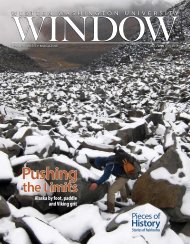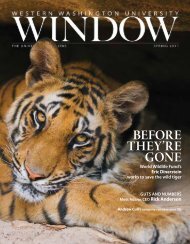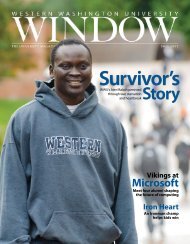WINDOW
Gratitude - WINDOW - The magazine for WWU
Gratitude - WINDOW - The magazine for WWU
- No tags were found...
You also want an ePaper? Increase the reach of your titles
YUMPU automatically turns print PDFs into web optimized ePapers that Google loves.
WWU News<br />
WWU News<br />
‘Bird Herd’ brings prehistoric<br />
bird’s footprint to WWU<br />
While investigating a landslide in the Mount Baker<br />
foothills in Whatcom County, WWU faculty found a fossilized<br />
footprint of a prehistoric Diatryma, a 7-foot-tall,<br />
380-pound flightless bird that lived in the Pacific Northwest<br />
56 million years ago.<br />
The 1,300-pound sandstone slab with the foot-long<br />
Diatryma track was later carefully lifted by helicopter to a<br />
nearby road and trucked to Western. It is now on display<br />
in the WWU Geology Department.<br />
Keith Kemplin (’81), a Bellingham software writer and<br />
geology hobbyist, spotted the fossil in May 2009 while<br />
exploring a massive landslide in the Racehorse Creek area<br />
with WWU Geology Researcher George Mustoe (’71 and<br />
’73), who immediately recognized its significance. Fellow<br />
Geology researcher David<br />
Tucker (’74 and ’04)<br />
soon convened a “Bird<br />
Herd” of people working<br />
together to protect<br />
the slab.<br />
The newly found<br />
foot track sheds further<br />
light on the life of this<br />
giant bird. Diatryma is<br />
popularly portrayed as a<br />
ferocious predator, chasing<br />
down and devouring<br />
small mammals, including<br />
small ancestors of<br />
horses. But this track<br />
shows the prehistoric<br />
AMNH Bulletin , No. 37, Article 11<br />
Big, but not scary: Diatryma, with stubby<br />
toes, might have devoured plants, not<br />
small animals.<br />
bird had only small, stubby, triangular claws on its toes,<br />
not the grasping talons typical of the carnivorous birds<br />
often shown in artists’ representations of Diatryma. The<br />
huge bird may have actually used its strong beak to crush<br />
tough leaves, and giantism is common in flightless birds<br />
with a vegetarian diet.<br />
The new track is being compared to a larger, threetoed<br />
track found east of Auburn in 1992. Some scientists<br />
initially accepted this first find as a footprint of a<br />
Diatryma, while others believed that it might have been<br />
a psuedofossil or other artifact – or possibly even a hoax.<br />
“Discovery of this amazing foot track is the first undoubted<br />
evidence that these birds existed here,” says Mustoe.<br />
“It’s quite a find.”<br />
Bird Herders Sue Madsen, Dave Sonnen and Keith Kemplin, top,<br />
prepare the slab, with the foot-long bird print, to be lifted by<br />
helicopter to a waiting truck. The Diatryma track is now on display<br />
in the WWU Geology Department. Photos by John Scurlock.<br />
WWU’s Outdoor Sculpture Collection Turns 50<br />
Western Washington University’s nationally respected Outdoor Sculpture Collection<br />
marks its 50th anniversary this year. While you may have spent many hours<br />
on campus walking among the art, how much do you know about the collection?<br />
WWU leads the region in public art: Before the state’s 1-percent-for-art law<br />
funded public art in state building projects, WWU had already begun a tradition of<br />
incorporating sculpture into new developments, largely through grants and private<br />
donations. Important contributors include Virginia and Bagley Wright and the<br />
National Endowment for the Arts. During WWU’s major growth periods in the<br />
’60s and early ’70s, seven sculptures were installed, beginning in 1960 with James<br />
FitzGerald’s “Rain Forest,” a bronze fountain now located near the Wade King<br />
Student Recreation Center entrance.<br />
Some nationally known artists are included in the collection: The collection<br />
includes works by five internationally acclaimed artists, including Mark di<br />
Suvero, who was at the controls of the crane building “For Handel” in the red paved<br />
plaza of the Performing Arts Center in 1975. “We have always chosen artists who<br />
are in the forefront of contemporary cultural trends or artists who have excelled<br />
and achieved acclaim from art authorities,” says Sarah Clark-Langager, director of the Western Gallery and curator<br />
of the Outdoor Sculpture Collection.<br />
It’s not just the sculptures, but where they’re placed: The sculptures<br />
themselves surely add to the campus’s beauty, Clark-Langager<br />
says, but the collection’s real strength is its integration into everyday life.<br />
George Trakas’ “Bay View Station” creates a convenient pathway along<br />
the hillside below the Performing Arts Center – and a place for contemplating<br />
the connections between the university and the surrounding city.<br />
The outdoor collection is going indoors: Scott Burton’s “Two-<br />
Part Chairs, Right Angle Version (a Pair),” sit in Haggard Hall at the<br />
foot of the formal staircase leading to the library; di Suvero’s “Mind’s<br />
Eye” sits upstairs as well. And the next addition to the collection will<br />
be a sculpture by Korean artist Do-Ho Suh, to hang in the architectural<br />
wells of the AIC building.<br />
“Bay View Station” by George Trakas, 1987.<br />
“The Man Who Used to Hunt Cougars for Bounty,”<br />
by Richard Beyer, 1972.<br />
“Skyviewing Sculpture,” © The Isamu Noguchi<br />
Foundation and Garden Museum, 1969.<br />
Learn more: Go to www.wwu.<br />
edu/window for links to an<br />
online tour of WWU’s Outdoor<br />
Sculpture Collection, and read<br />
an excerpt from Clark-Langager’s<br />
conversation with Richard<br />
Beyer, who tells a lively story<br />
about the origins of his sculpture,<br />
“The Man Who Used to<br />
Hunt Cougars for Bounty,”<br />
8 <strong>WINDOW</strong> • Fall 2010 • Western Washington University<br />
“For Handel” by Mark di Suvero, 1975.<br />
www.wwu.edu/window<br />
9








